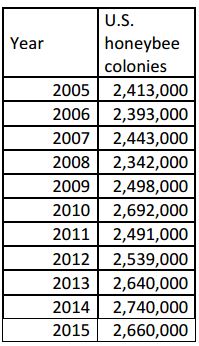 Why is it that environmental groups always make women look stupid? Perhaps because environmental groups don't like women. That would explain why the wage gap in the environmental sector is so much larger than in engineering. Image link: BBC
Why is it that environmental groups always make women look stupid? Perhaps because environmental groups don't like women. That would explain why the wage gap in the environmental sector is so much larger than in engineering. Image link: BBC
The Bee Informed Partnership takes an annual survey of commercial and backyard beekeepers in order to track health and survival rates of honey bee colonies. The latest results show that colonies declined 44 percent during the year spanning April 2015 to April 2016.
That sounds alarming, and it is in contrast to studies showing that bee numbers are not in decline, they were instead at a 20-year high last year.(1)
How can the claims be so different? Should we be alarmed or not?
There are three reasons why lazy journalists who rewrite Friends of the Earth press releases are not only getting it wrong claiming pesticides are a cause, they are misrepresenting the data:
1) Surveys are not studies. Beekeeping has become a fad and that means a whole lot of amateurs have killed a whole lot of bees. Despite what the kind of people who go into amateur beekeeping in the last few years think, you can't just stick a hive in your backyard and watch the awesome power of nature take over. Well, nature will take over, but it will be the mean kind of nature -- the bees will die. More bees are killed in truck accidents than due to pesticides, but that doesn't show up in surveys or in press releases from environmental groups. If I were a bee, I'd be really "stressed" about being hauled on a truck out to some place that will sell or rent me to an amateur beekeeper likely to kill me with incompetence.
2) They use both winter loss and summer loss combined. Lots and lots of bees die during the winter, and the harsher the winter the more they die, so this combined number doesn't have much validity because it hasn't been gathered long enough -- only six years. On the other hand, the more recent term Colony Collapse Disorder is actually a recurring issue that has been documented for as long as beekeeping has been documented. See reports in the years 950, 992, 1443, 1853, 1868, 1891, 1896, 1903, 1905, 1918, 1919, in the 1920s, the 1930s, the 1960s, 1975 and 1995. During those early years they had low literacy. Imagine how many collapses would have been recorded if everyone knew how to write.
The real difference this year over last: 3.5 percent. In nature, that is statistical wobble.
3) One-off results are not really telling much of a science story. Activists are promoting this latest number as an impending Neonicotinoid pesticide doomsday only your check or credit card donation (act now!) can prevent, but scientists recognize there are many factors contributing to wild swings in bee deaths. The biggest culprit is the varroa mite, a deadly parasite that rapidly spreads between colonies but doesn't show up in surveys. And there are changes in climate and land use that make a difference -- weather is the big reason northern Europe seemed at one point to have more bee losses while Australia, which uses plenty of neonics pesticides, had no decline in bees at all.
Though journalists are making this a pesticide issue, the scholars behind the work don't.
"We're now in the second year of high rates of summer loss, which is cause for serious concern," Dennis vanEngelsdorp, an assistant professor of entomology at the University of Maryland and project director for the Bee Informed Partnership, said in its statement. "Some winter losses are normal and expected. But the fact that beekeepers are losing bees in the summer, when bees should be at their healthiest, is quite alarming."
He said much the same thing last May, and implicated parasites: "Our biggest surprise was the high level of varroa, especially in fall, and in well-managed colonies cared for by beekeepers who have taken steps to control the mites. We knew that varroa was a problem, but it seems to be an even bigger problem than we first thought. Moreover, varroa's ability to spread viruses presents a more dire situation than we suspected."
Indeed. They are, as he called them, dirty hypodermic needles that are a vector for viruses.
Who will be impacted most by these mites? Small beekeepers, like the amateurs in point 1, who don't have any varroa control strategies in place. But due to that lack of knowledge or unwillingness to engage in pest control, their problem will result in even good beekeepers who control mites losing colonies as the disease spreads.
Estimates of economic "value" say honeybee pollination is worth up to $10 billion annually. At some point it might make sense to pay Natural Resources Defense Council donors not to become amateur beekeepers thinking they are saving Gaia. They are probably doing more harm than good.
NOTE:
(1) http://www.ars.usda.gov/News/docs.htm?docid=15572




